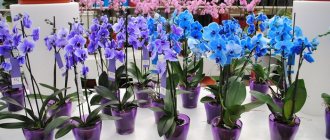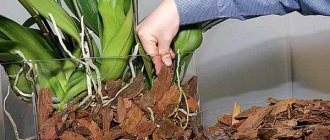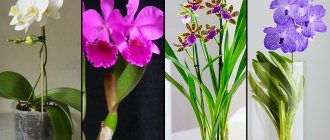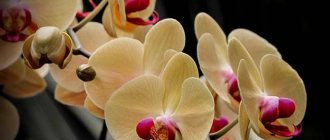White orchids are flowers that were first discovered in Indonesia and Southern China. Today the plant can be found on the plains and in tropical forests, as well as on the windowsills of most orchid lovers. Phalaenopsis has captivated flower growers so much that they do everything possible to keep the flower blooming and developing.
Considering that the presented species of orchids blooms regardless of the time of year, you can enjoy snow-white blooms almost all year round. With proper care, the plant will bloom for more than 6 months a year.
What is it like: home care
Many gardeners worry that care at home will require a lot of effort and time. Although this is not at all true.
Breeders bred the white phalaenopsis orchid just for home cultivation. Therefore, you don’t need to worry about the temperature in the room being unsuitable or having to constantly worry about air humidity. But it has not yet been possible to breed a completely black orchid, although there are some species that are very close to this color.
All care usually comes down to the following points:
- landing;
- lighting;
- watering;
- feeding;
- soil;
- pruning and replanting.
By adhering to some rules, it will be possible not only to grow white orchids, but also to propagate them.
Landing
It is recommended to plant a white orchid in a transparent pot. You need to pay attention to the fact that there are small holes at the bottom for aeration. Before planting the flower, drainage must be poured onto the bottom. Beginning flower growers are recommended to buy a special substrate in stores. Those who already have experience growing similar flowers can prepare the soil themselves. To do this, you will need to take dry bark, a little sphagnum moss and charcoal.
Lighting
Without light, the orchid will die, so it needs to be provided with good lighting. In the summer, a flowerpot with a flower can be placed relatively close to the window. However, you need to make sure that the plant is not exposed to direct sunlight all day. In winter, you may need an additional light source, such as a fluorescent lamp.
Despite the fact that phalaenopsis takes root well at any temperature, it is best that it is within +20..+23°C. A mark below +15 °C is quite alarming; at low temperatures the plant may even die.
Watering
The white orchid does not require frequent spraying or watering. As soon as it has been noticed that the tree bark (and this is the main part of the substrate) has dried well, manipulation can begin. In hot weather, the flower is usually watered a couple of times a week, and in winter, when the room is cool enough, the procedure can be carried out no more than three times a month.
Important! During flowering, the flower is watered from a watering can and is not moved from place to place.
Only clean water should be used. There can be no talk of any liquid from the tap. Considering that some apartments are very hot in winter, the plant may not have enough air humidity. In order to provide it to the flower, you should spray the phalaenopsis with a spray bottle or place a jar of water nearby.
Top dressing
There is no need to rush to fertilize the flower immediately after it was purchased . Fertilizers are applied only after a couple of years. They are sold in flower shops. Moreover, a non-blooming orchid is fertilized once a month, but a flowering orchid is fertilized 2-3 times a month.
The soil
Most gardeners buy ready-made substrate in stores. In principle, this is a good idea, since it practically eliminates the possibility of various pests getting into the flower with the soil. Although, if you do everything correctly, you can make your own soil mixture.
To do this you need to take:
- tree bark (4 parts);
- sphagnum moss (1 part);
- charcoal (1 part).
And mix it all well. The bark must be well dried and pre-boiled to prevent pests from entering the soil. It is also necessary to ensure that all components are neither large nor small in size. Because in the first case the substrate will be very large, and in the second it will resemble dust.
Are there varieties with this color?
Phalaenopsis is translated from Greek as Phalania ("night butterfly") and Opsis ("resemblance").
It received its name at the beginning of the 19th century thanks to Karl Blume, director of the Leiden Botanical Garden, who, while exploring the flora of the Malay Archipelago, mistook the snow-white phalaenopsis for a flock of white moths. In nature, white orchids in their pure form are extremely rare . For the most part, white flowers have yellowish or pink inclusions or contrasting edging of the petals. Meeting a pure white specimen is a great success.
How does a white orchid reproduce?
White phalaenopsis is quite difficult to breed. The interesting thing is that even experienced gardeners sometimes cannot do this.
However, everyone should know how the procedure is carried out in order to have at least some idea about it.
So, reproduction occurs:
- By dividing the stem (usually this method is used to rejuvenate the flower).
- Children. They appear on the peduncle. This happens rarely, but it does happen.
- By seating. If several rosettes with separate roots appear, then you should not hesitate, but plant them in separate flowerpots.
Features of these plants
To understand the characteristics of this flower, you need to know the conditions in which it grows in the wild. The phalaenopsis orchid comes from tropical forests, where the air temperature is 19-27 °C and the air humidity is very high.
Phalaenopsis is an epiphytic plant. That is, it grows on trees and stumps.
Tenacious aerial roots wrap around tree branches and serve as a support for the plant, clinging to which the phalaenopsis rises towards the light in the shady tropical forest. An orchid is not a parasite and does not cause any harm to the tree on which it grows.
Some white orchids reach a height of 1 m. There are also very miniature plants, the height of which does not exceed 30 cm.
In nature, the phalaenopsis orchid can bloom all year round. The number of buds depends on the condition of the plant and its size. Each flower lives up to three months! The total lifespan of the plant is about ten years. White phalaenopsis flowers have virtually no scent.
Pests and diseases of flowers
Often the plant is affected by various types of rot. This is due to an incorrect watering scheme. Fearing that the flower will dry out, flower growers begin to carry out uncontrolled irrigation or “soaking”. Of course, this leads to excessive soil moisture and root rotting. In order to eliminate this, you need to forget about watering for a while (for a couple of weeks), and then proceed according to the scheme.
If this does not help or the root system is already very rotten, then you cannot do without special means (such as phytosporin-M, for example).
Pests, if they do not bypass the white orchid, then attack it extremely rarely. You also need to fight parasites using special solutions.
Bloom
The main condition for an orchid to bloom is the length of daylight hours. When the right season arrives, the plant lays flower buds, which will be visible only after the development of flower stalks. A fairly long period of time may pass between the first appearance of buds and the beginning of their growth. If the peduncle begins to actively grow, then it continues to grow even with decreasing daylight hours. Excessive watering is a popular mistake, as a result of which the root system rots and the plant dies.
Problems when growing orchids
The white phalaenopsis orchid is unpretentious, but this does not mean that you can not care for it. If everything is done correctly, then nothing bad will happen to the plant. Problems are usually signaled by a long absence of flowering, yellowing of leaf blades, cracks in the leaves and even their falling off. In the case where this was noticed, certain reasons that could lead to this should be excluded or confirmed.
By properly caring for the flower, the white orchid will become a real decoration for your room or office space.
Recommendations
Anyone who wants to grow an orchid at home must keep in mind that this plant blooms for quite a long time and has practically no rest period.
If you care for orchids correctly and competently, the flowers can last on the peduncles for more than 1 month. After flowering, you need to make sure that there are no more buds on the plant, and only then can you trim the peduncle. When pruning, it is necessary to preserve approximately 3-4 buds, which are placed close to the leaf rosette. The instrument for this procedure must be clean and sharp.
Species of white orchids are considered quite complex plants that require increased attention and care. Nevertheless, they are quite popular among gardeners. This is an amazing flower that captivates with its variety of colors and shapes. There are many varieties of these plants. The class of orchids is one of the many in nature.
The best varieties of multiflora and features of caring for them
All of the listed groups of phalaenopsis can be multifloras. For example, Royal Green Apple with cascading flowering can, in fact, be considered a multiflora.
Among other “cascade players”, Sogo Yukidan is the most popular. This phalaenopsis forms long garlands of snow-white flowers, the length of which can reach up to half a meter.
However, multifloras include phalaenopsis not only with cascade flowering. Any variety that can branch a peduncle well and produce more than one arrow at a time can be considered multiflora. For example, these orchids include the following varieties:
- Brown Sugar. Phalaenopsis with a purple-brown flower, the petals of which have a snow-white edge.
- Dragon. Phalaenopsis with a peach round flower with delicate dark specks at the base of the petals.
- C*322. Phalaenopsis with a soft pink main color of the corolla, covered with large scarlet specks.
Multifloras need good care, otherwise you won’t be able to achieve abundant flowering.
Particular attention should be paid to fertilizing. The application of phosphorus-containing fertilizers during the period of flower stalk growth will allow the plant to form a large number of viable flower buds
Home flowering of cascade multifloras is different from the greenhouse, but still remains impressive. Fertilizing and intense lighting help increase the number of flowers or enhance the branching of peduncles.
Cattleya
Cattleya is native to the tropical forests of South America. The main feature of this orchid is the middle petal, which has a different color from all the others. The plant has quite large flowers; there can be no more than 5 buds on one peduncle. Cattleya leaves are dense and oval in shape. Growing cattleya at home will require a lot of effort.
External characteristics of Phalaenopsis Amabilis
"Amabilis" is the progenitor of many hybrids growing in nature. It can be found in Borneo, Ambon, Australia, northern Philippines, New Guinea, Java and the Celebes Islands.
Mature plant height
The plant itself is a monopodial epiphyte, stem size from 10 cm to 50 cm , with 4-5 double-rowed, long, elliptical, fleshy leaves.
Phalaenopsis amabilis.
Maximum peduncle length
The flower stalks of an adult plant can reach a meter in length. Depending on the growing conditions, they have an average height of 60 to 90 cm.
It often produces a pair of fairly branched, arched, purple-colored flower stalks at once.
Flower diameter
Typically, 15 flowers develop simultaneously on a peduncle, but an adult plant can bear up to 70 fragrant flowers at the same time.
Their diameter on average ranges from 7 to 9 cm . There are specimens whose diameter can be up to 12-13 cm.
The wide petals and sepals look impressive, having a milky white color with a hint of pink on the outside.
Botanical description of Volzhanka
Volzhanka is distributed in temperate zones of the Northern Hemisphere.
The generic scientific name is given for the appearance of the inflorescences. Pre-Linnaean botanists called it "barba caprae" - "goat's beard", Carl Linnaeus renamed the plant "aruncus", from the Greek "arynkos" with the same meaning.
According to the botanical description, Volzhanka is a perennial herbaceous plant that is valued for its lush openwork foliage and beautiful large inflorescences. The height of the bush depends on the variety and can vary from 20 to 200 cm. The width of an adult bush can reach from 50 to 120 cm. The stems are strong and straight. The root system of the plant lies close to the soil surface and has strong branching. With age, the roots become woody and grow to the sides.
The leaves are compound, twice or thrice pinnately dissected, jagged along the edges, dense, even hard, dark green. Attached to long petioles. Stipules are absent.
Peduncles are long, up to 60 cm. The flowers are dioecious, small, white or cream, collected in a complex racemose panicle. Female flowers are more magnificent and dense. Men's ones are more sparse and have an openwork edge. Flowers form at the top of the plant. Arunkus blooms in late June - early July. The flowers have a strong aroma that attracts insects.
The fruit is a leaflet with a leathery pericarp, inside which contains small, thin seeds.
A photo of the plant is attached to the description of Volzhanka, so that gardeners can better imagine this crop.











